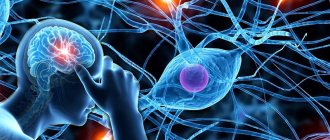Over the 150 years that medicine has known this disease, the disease itself has changed, and its treatment has become completely different. Today, doctors advise patients to perceive this diagnosis not as a death sentence with a short delay, but as a challenge. Because with multiple sclerosis you can live life to the fullest. You just need to gain strength and patience.
Our experts:
President of the All-Russian Public Organization of Disabled People with Multiple Sclerosis, Chairman of the Council of Public Organizations for the Protection of Patients' Rights under Roszdravnadzor Yan Vlasov.
Professor of the Department of Neurology of the First St. Petersburg State Medical University. acad. I. P. Pavlova Natalya Totolyan .
Myth No. 1. Only old people get multiple sclerosis. This is a condition associated with memory loss
In fact . This disease is not associated with atherosclerosis (and serious memory impairment is a very rare symptom). Multiple sclerosis is a progressive pathology of the central nervous system. It develops as a result of autoimmune inflammation with damage to the myelin sheaths of nerve fibers, which gradually leads to the death of nerve cells. During exacerbations, multiple scattered foci of inflammation and sclerosis (scarring) form in the brain and spinal cord, which manifests itself in new symptoms or intensification of old ones.
Most often, multiple sclerosis begins at a young age (25-40 years), up to 10% - in children. Around the world, 2.5 million people suffer from this disease. In Russia, according to official data, there are 90 thousand (according to unofficial data, 150 thousand). On average, the annual increase in patients is 7%.
You're lying, you won't take it! New in the treatment of multiple sclerosis Read more
Treatment of multiple sclerosis
Treatment requires complex action. The earlier therapy is started, the greater the chance of slowing the progression of the disease and achieving stable remission.
The main purpose of the effect is to change the activity of the immune system and stop the destruction of nerve cell processes. Depending on the form and stage of the disease, the following are used:
- corticosteroids for temporary suppression of immunity (prescribed during exacerbation of the disease);
- immunomodulators for the prevention of exacerbations (used during the attenuation of symptoms);
- plasmapheresis: hardware purification of blood plasma from antibodies;
- interferons to inhibit destruction processes;
- drugs that suppress the immune system (with rapid progression of the pathology).
In parallel, symptomatic therapy is prescribed:
- antispasmodics;
- antidepressants;
- nootropic drugs;
- angioprotectors;
- painkillers, etc.
The selection of drugs depends on the type and severity of symptoms.
Outside of exacerbations, procedures are prescribed to stimulate the functioning of the nervous system and muscles:
- physical therapy and daily exercises for different muscle groups;
- physiotherapy (with the exception of warming procedures);
- psychotherapy;
- massage;
- Spa treatment;
- vitamins (especially vitamin D).
Make an appointment
Myth No. 2. The main symptom of multiple sclerosis is problems walking.
In fact . Multiple sclerosis is called the disease with a thousand faces. Often the first sign may be blurred vision in one eye, numbness in an arm or leg, headaches and dizziness, and problems with coordination. Sometimes it's just increased fatigue or problems holding urine. Therefore, internists, ophthalmologists and urologists are often the first to encounter the disease. It is sometimes difficult to recognize a disease early, so special schools of neurologists are regularly held, where doctors are taught to be alert to a variety of symptoms that this disease may signal.
Until recently, diagnosis was delayed for 5-8 years. Today in Russia the situation has improved dramatically due to the fact that the community of neurologists and public organizations studying multiple sclerosis are conducting educational activities on this problem. However, the disease can be completely asymptomatic for several years. In this case, it can only be detected with magnetic resonance imaging (MRI), which shows altered areas on tomograms of the brain or spinal cord. The neurology community even proposed to the Ministry of Health to introduce screening for multiple sclerosis from childhood. But MRI is an expensive method, so such screening is not yet available.
Symptoms
With multiple sclerosis, life expectancy will be longer if the pathology is diagnosed at an early stage of its development. Therefore, it is so important to pay attention to the slightest changes in your own well-being.
Early signs:
- trembling of the limbs - changes in handwriting, tremor of the fingertips;
- impaired skin sensitivity - constant tingling of a certain part of the body, chilliness, loss of the feeling of a solid surface underfoot;
- lack of coordination of movements - awkwardness, staggering when walking;
- deterioration of vision - an image as if through dirty glass, black dots before the eyes;
- emotional deviations – previously uncharacteristic irritability, suspiciousness, tendency to depression;
- constant fatigue and increased fatigue.
As the number of demyelinated areas increases, the signs of multiple sclerosis will become more pronounced, both physically and mentally. Problems with self-care, involuntary loss of urine in combination with constipation, a sharp weakening of memory and mental disorders appear. Such people require constant attention, household care and assistance. They have to help with everything, live in the same apartment and take care of them every day.
Myth No. 3. Only an MRI of the head can confirm the diagnosis.
In fact . The main methods for diagnosing multiple sclerosis are clinical manifestations in combination with MRI data and cerebrospinal fluid (CSF) analysis. To analyze the CSF, a lumbar puncture is made, 1-2 ml of fluid is obtained and tested for oligoclonal immunoglobulins - their presence confirms the inflammatory process. These tests are safe and recommended in most cases for early diagnosis. There are also additional instrumental studies: evoked potential techniques, coherent optical tomography and others.
Symptoms
The first signs of multiple sclerosis are nonspecific and often go unnoticed by both the patient and the doctor. In most patients, the onset of the disease is manifested by symptoms of pathology in one system, and later others become involved. Throughout the disease, exacerbations alternate with periods of complete or relative well-being. The first signs of multiple sclerosis include symptoms such as blurred vision, urinary retention, loss of coordination when walking, and even itchy skin. It is worth dwelling in more detail on the possible symptoms of the onset of multiple sclerosis.
Damage to cranial nerves
When the optic nerve is damaged, patients experience retrobulbar neuritis. Its signs are:
- Sudden, periodic decrease in visual acuity in one eye;
- Episodic fog before the eyes;
- Changes in visual fields;
- Color vision impairment;
- Pain, foreign body sensation;
- Photosensitivity;
- Loss of visual contrast.
In addition, the patient may experience intermittent, unilateral, localized headaches. During a diagnostic examination, the ophthalmologist can reverse pallor and swelling of the optic nerve head, a change in the normal pupillary reaction to light. Retrobulbar neuritis is a direct indication for magnetic resonance imaging.
If the oculomotor and trochlear nerves are affected, patients begin to experience double vision, and as multiple sclerosis progresses, drooping of the eyelid or strabismus occurs. Also, with the onset of multiple sclerosis, a characteristic symptom will be a violation of coordinated eye movement when the patient looks up and to the sides.
Involvement of the trigeminal and facial nerves in the pathological process is manifested by a violation of the facial muscles, a decrease in the sensitivity of the facial skin, sclera and cornea of the eyes. For example, drooping of one corner of the mouth, skewing of the eyebrows on one side, failure to close the eyelids, turning off the muscles on one side of the face.
Cerebellar lesion
Symptoms of MS when the cerebellum is involved include:
- Episodes of dizziness;
- Change in gait;
- Balance imbalance;
- Deterioration of handwriting;
- Trembling of limbs;
- Nystagmus, that is, spontaneous movements of the eyeballs.
Sensory disorders
A patient diagnosed with multiple sclerosis at the onset of the disease will often complain of uncaused discomfort on the skin and limbs. For example, manifestations of the onset of the disease include a feeling of tingling, numbness in the legs and arms, burning and itching of the skin, the feeling of a “foreign” limb, decreased superficial and deep sensitivity. Correct diagnosis of multiple sclerosis is based on a thorough examination by a neurologist identifying all possible complaints.
Pelvic disorders
MS can debut with urinary disorders, and as a result the patient turns not to a neurologist, but to a urologist, which only confuses the doctor and complicates the diagnosis, and most importantly, takes time. Signs of MS from the genitourinary system are as follows:
- Frequent urination;
- Urinary retention;
- Uncontrolled urination;
- Inability to urinate;
- Erectile dysfunction in men;
- Disorders of the menstrual cycle in women.
Movement disorders
Pathological changes in the motor sphere can be very diverse - from muscle weakness, which goes away after rest, to complete loss of the ability to perform any actions. The patient may initially complain of difficulty performing fine motor skills; sudden awkwardness when performing household chores that previously did not cause difficulties; muscle tension; strengthening tendon reflexes
Special attention is paid to:
- Disappearance of abdominal reflexes, which is diagnosed during a neurological examination;
- The appearance of pathological reflexes of the feet;
- Paresis of the limbs;
- Nocturnal involuntary muscle cramps of the feet or night cramps.
Cognitive impairment
The patient's relatives and colleagues may notice changes in his behavior and mental functioning. For example, a person became more emotionally unstable, irritable, began to experience difficulties in performing mental work that did not previously cause them, problems with remembering and reproducing information. Because of such disorders, patients with multiple sclerosis need social support in life.
Myth No. 4. The cause of the disease is viruses
In fact . Multiple sclerosis, like most chronic diseases, is a multifactorial pathology. A number of factors that provoke the disease cannot be influenced, but we can eliminate some (the so-called modifiable factors), thereby reducing the risk of MS and its more severe course.
Science knows of numerous hereditary factors of predisposition to MS (however, there are also genes that protect against the disease). The risk is also increased by an unfavorable environment, smoking, excess salt in the diet, deficiency of sunlight and vitamin D. Numerous studies in recent years also indicate the role of changes in the composition of the intestinal microflora in the development of autoimmune inflammation and even damage to nerve cells in MS.
“Untimely encounters” with some viruses also play a role. For example, the risk of developing multiple sclerosis increases later infection (in adolescence and older age) with the Epstein-Barr virus, which is accompanied by infectious mononucleosis. Some retroviruses, which at the dawn of the evolution of the animal world were “inscribed” in our genome, subsequently left their “messages” in our genes, which also contribute to the development of MS. In addition, patients with this disease are known to have an initially impaired immune response to some viruses.
Sclerosis, but not that one. By what signs are multiple pathologies recognized? Read more
PsyAndNeuro.ru
Neuropsychiatric syndromes are common in multiple sclerosis (MS). Unfortunately, there is little scientific literature on psychopharmacology in multiple sclerosis.
The absence of a high-quality evidence base can justify the refusal of psychopharmacological therapy. This approach is practiced when drawing up clinical recommendations based on the principles of evidence-based medicine.
There are no high-quality studies on the use of psychopharmacological methods in multiple sclerosis. In such a situation, a different approach can be taken—using the general principles of evidence-based psychopharmacology when treating patients with MS.
The material was prepared with the support of the Doctor SAN Psychiatry Clinic (St. Petersburg)
Depressive disorder due to other health conditions is a diagnosis that appears appropriate for patients with MS and depressive symptoms. However, in reality, the use of this diagnostic category is associated with significant problems. To make such a diagnosis, it is necessary to prove that depression is a direct, physiological consequence of another illness, which is difficult to do due to the fact that depression is usually based on a complex combination of causes.
Antidepressants
The only depressive disorder whose treatment has been studied in relation to MS (three small RCTs) is major depressive disorder. The authors of a Cochrane review on this topic, based on the low quality of studies, concluded that antidepressants are unproven in the treatment of depression in MS. Experts from the American Academy of Neurology came to the same conclusion.
There are few similar studies testing the effectiveness of antidepressants in treating depression in groups of people with certain diseases. The question of the effectiveness of antidepressants in the MS patient population has received comparatively more attention because the pathophysiology of depression in MS is believed to have unique features. However, this assumption remains unproven.
The use of antidepressants in the treatment of depression in patients with MS can be considered clinically justified. Three studies on this topic examined the effects of desipramine, sertraline and paroxetine. There is no reason to limit your choice of antidepressant only to these drugs. When selecting an antidepressant, you should be guided by general principles, while taking into account several specific points.
- Fatigue is one of the most common symptoms of MS. Patients with MS do not tolerate medications with strong sedative effects, including sedating antidepressants (eg, trazodone, mirtazapine, and amitriptyline).
- Most patients with MS develop symptoms of cognitive impairment at various stages of disease development. Antidepressants with anticholinergic effects (TCAs, paroxetine) may have a negative effect on cognition and should be avoided.
- Balance problems are common with MS. Accordingly, antidepressants that can cause orthostatic hypotension (most TCAs, trazodone, mirtazapine) increase the risk of falls. This warning is especially relevant for patients with frequent nighttime urination.
SSRIs
SSRIs are most often prescribed as first-line treatment for patients with MS and depression. Some SSRIs may affect the QTc interval and may theoretically be problematic when starting fingolimod. There are reports that the first dose of fingolimod is associated with bradycardia and slowing of AV conduction, so the antidepressant may be temporarily suspended at the start of fingolimod treatment.
Bupropion
Another drug suitable for patients with MS may be bupropion, which does not usually cause fatigue and does not produce significant anticholinergic and alpha-adrenergic (eg, orthostatic hypotension) side effects. However, bupropion may lower the seizure threshold more significantly than other antidepressants, so a history of seizures is considered a contraindication for the use of bupropion. In MS, the risk of seizures increases, therefore, the use of bupropion should be treated with caution.
Interferons
In the past, use of interferon beta-1a and beta-1b has been associated with the development of depression and increased risk of suicide in patients with MS. However, empirical studies over the past 20 years have refuted the existence of such a connection.
TCA
The use of TCAs should be avoided, but there are situations in which their use may be justified. TCAs are sometimes prescribed in low doses for chronic and neuropathic pain, which is very common in MS. If a depressed patient who is already taking a low dose of a TCA (and is tolerating the prescribed drug) develops pain, it is better to increase the dose rather than prescribe an additional drug.
Bipolar disorder
There are no studies on the treatment of bipolar disorder in patients with MS. Lithium may be poorly tolerated in patients with MS due to gastrointestinal and polyuric side effects. In addition, people with mobility problems may not be comfortable with frequent laboratory monitoring. The use of divalproex is complicated by its sedative effect. When treating mood disorders in patients with MS, one should be guided by the well-known principle “Start slow, keep going slow.”
There have been reports that corticosteroids, which are sometimes used to treat MS, cause symptoms of mania in people with MS. In such cases, long-term treatment with mood stabilizers is probably not necessary. In addition, it is known that euphoria can be a manifestation of MS. The euphoric state in MS is usually mild in nature and is accompanied by severe cognitive impairment. In addition, it does not have characteristics that indicate mania, such as faster thinking, decreased need for sleep, and decreased appetite. Therefore, it is not difficult to distinguish euphoria in MS from elevated mood in a manic or hypomanic state. In this case, there is no need to prescribe psychopharmacological treatment.
Pseudobulbar affect
Uncontrollable laughter or crying not associated with severe mood disorders occurs in a variety of neurological disorders. Pathological laughing or crying has also been mentioned in MS studies. The accepted term for this phenomenon, pseudobulbar affect, is usually used when the syndrome occurs in diseases such as Alzheimer's disease, amyotrophic lateral sclerosis, Parkinson's disease, stroke, and traumatic brain injury. Clinically significant manifestations of this syndrome occur in 10% of MS patients.
Traditional treatment of pseudobulbar affect is low doses of antidepressants with a predominantly serotonergic effect. However, the only drug with proven effectiveness is dextromethorphan, which is prescribed in combination with quinidine, which slows down the hepatic metabolism of dextromethorphan.
Anxiety disorders
There are no studies on the treatment of anxiety disorders in patients with MS. The use of benzodiazepines is inappropriate due to their effects on cognition, increased risk of accidents, poor balance and increased fatigue.
Antidepressants in the treatment of panic disorder and generalized anxiety disorder should be selected taking into account the characteristics indicated in the section “Depressive disorders”.
Psychotic disorders
There are no studies on the treatment of psychotic disorders in patients with MS. The use of first-generation antipsychotics is problematic because many patients with MS are sensitive to extrapyramidal side effects.
Some second-generation antipsychotics, such as risperidone, also cause these types of side effects. The most sedating second-generation antipsychotics, such as olanzapine, are poorly tolerated in people with MS. If these drugs are prescribed long-term, careful monitoring of the patient's condition is required, which should include measurement of body weight, waist circumference, blood pressure, glycated hemoglobin levels, fasting glucose and lipid profile studies.
Extreme fatigue
Severe fatigue is an important symptom of MS, and increased fatigue affects both motor and cognitive functions and affects a person's motivation. Fatigue may be a secondary effect of medications prescribed to treat neuropathic pain in MS (eg, gabapentin, pregabalin) or to treat muscle spasms (eg, baclofen). Sleep disturbances characteristic of MS can also lead to increased fatigue. Fatigue in MS is made worse by fever or infection, especially urinary tract infections.
In the past, fatigue was treated with stimulants such as amphetamine, but there is no justification for this practice. Another drug used is amantadine, an antiviral and anti-parkinsonian drug. Its effectiveness has been assessed mainly in small, low-quality studies, and a Cochrane review rated its effectiveness and tolerability as poorly proven. Studies on the effectiveness of modafinil have produced conflicting results. At the same time, clinical observations indicate that psychostimulants can temporarily reduce drowsiness and fatigue in patients with MS.
In general, non-pharmacological methods are recommended to relieve fatigue. Many MS patients are able to develop their own strategy to combat fatigue. It is important to note that after excessive activity at times when patients feel well, especially severe fatigue comes. Psychostimulants may mask physical fatigue, leading to poor symptom control.
- Avoid the use of drugs with strong sedative effects, anticholinergics and drugs that provoke orthostatic hypotension.
- Patients with MS often take many medications. For this reason, it is recommended to carefully study the issue of drug interactions, and also, if possible, refrain from combining antidepressants or using augmentation.
- The changes in the immune system characteristic of MS can affect any part of the central nervous system, so the disease manifests itself in a wide variety of ways. Patients become experts on their own, individual version of the disease. Therefore, clinical decisions should always be discussed with the patient.
The material was prepared with the support of the Doctor SAN Psychiatry Clinic (St. Petersburg)
Author of the translation: Filippov D.S.
Source: Patten S. Psychopharmacology of multiple sclerosis. Handbook of Clinical Neurology, Vol. 165 (3rd series) Psychopharmacology of Neurological Disease, ed. VI Reus and D. Lindqvist, 2019
Myth No. 6: Multiple sclerosis is incurable. All you have to do is come to terms with it
In fact . At the moment, this disease cannot be cured, but most often it can be controlled. Over the past decade, the lives of patients with multiple sclerosis have changed dramatically. With the advent of several generations of drugs, the so-called DMTs (drugs that modify the course of multiple sclerosis), doctors have the opportunity not only to alleviate symptoms, but to prevent exacerbations and subsequent disability. The number of such drugs is growing every year.
Prognosis and risks for MS
The prognosis depends on the stage at which the disease is detected, what its type is and the general resistance of the body. The following types of MS are distinguished:
- Benign - with this type, the intervals between attacks become faster, the myelin sheath has time to recover.
- Remitting course - in this case, periods of exacerbation can last several weeks, and recovery occurs through a long cycle.
- Primary progressive MS is characterized by the absence of clear symptoms of exacerbation, but leads to a gradual deterioration of the condition.
- Secondary progressive or chronic MS - initially occurs as a remitting type, but over time it steadily begins to progress.
- Progressive-remitting MS occurs with constant deterioration and periodic acute outbreaks of the disease.
- Multiple sclerosis gradually leads to the fact that a person cannot independently perform usual social activities, self-care and professional responsibilities.
Which group of disabilities the patient will receive depends on the nature of the disease. Thus, with benign MS, disability is not awarded, life expectancy remains at the same level.
With a relapsing course, life expectancy is reduced by 7 years; depending on the condition, the patient is assigned disability group 3.
Life expectancy - 40 years or more - is an extremely rare phenomenon, because in order to establish this fact, you need to find people who got sick back in the 70s of the 20th century.
Difficult. With a malignant course of MS, some die after 5-6 years, while the sluggish process allows a person to remain in an active working state for quite a long time.
Myth #7: Multiple sclerosis medications suppress the immune system. Therefore they are very harmful and dangerous
In fact . All PEDs suppress not immunity, but immune inflammation. There are 1st line drugs, which include milder drugs (immunomodulators), as well as 2nd line drugs - selective immunosuppressants that selectively affect the immune system, reducing its autoaggression. Not all DEDs need to be taken constantly. There are drugs whose treatment course lasts only a few days a year, but the effect can last for a very long time if the treatment was timely.
Myth No. 8. Innovative medicines are not available to Russian patients
In fact . All innovative drugs for multiple sclerosis registered in the world are available to Russian patients. Patients can receive most DMTs free of charge: multiple sclerosis is included in the list of nosologies for which centralized preferential provision of drugs is provided. The latest drugs become available in Russia with a delay of 2-3 years, but doctors even find advantages in this fact. This delay allows the development of measures to prevent possible complications of therapy, which are identified precisely in the first years of widespread use of the new drug.
Broken bike. How do people with multiple sclerosis feel? More details










